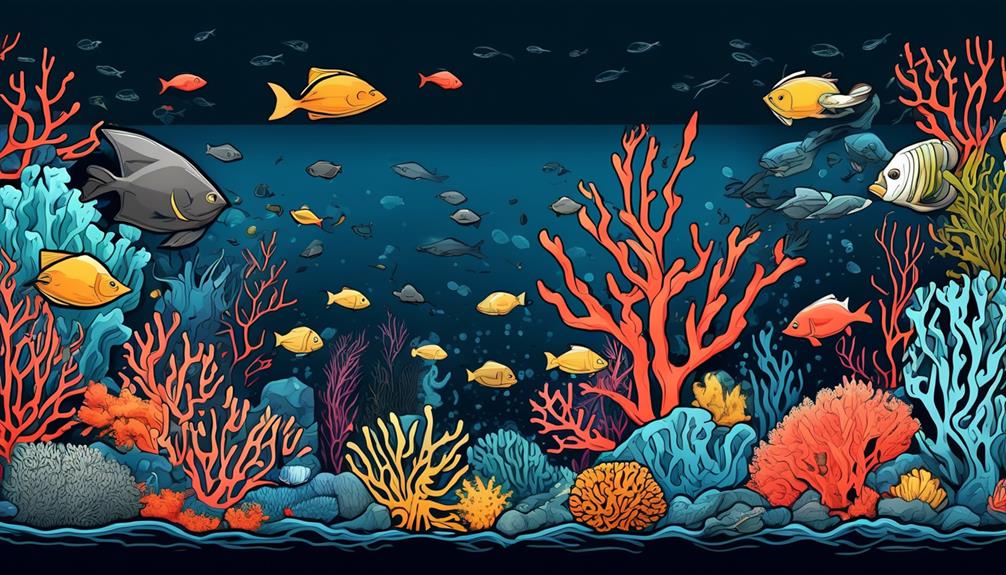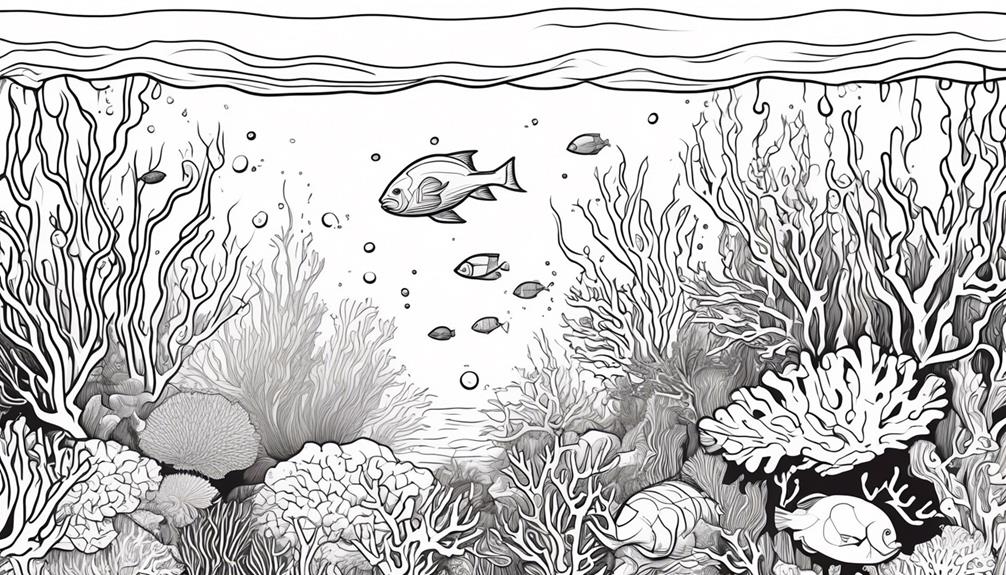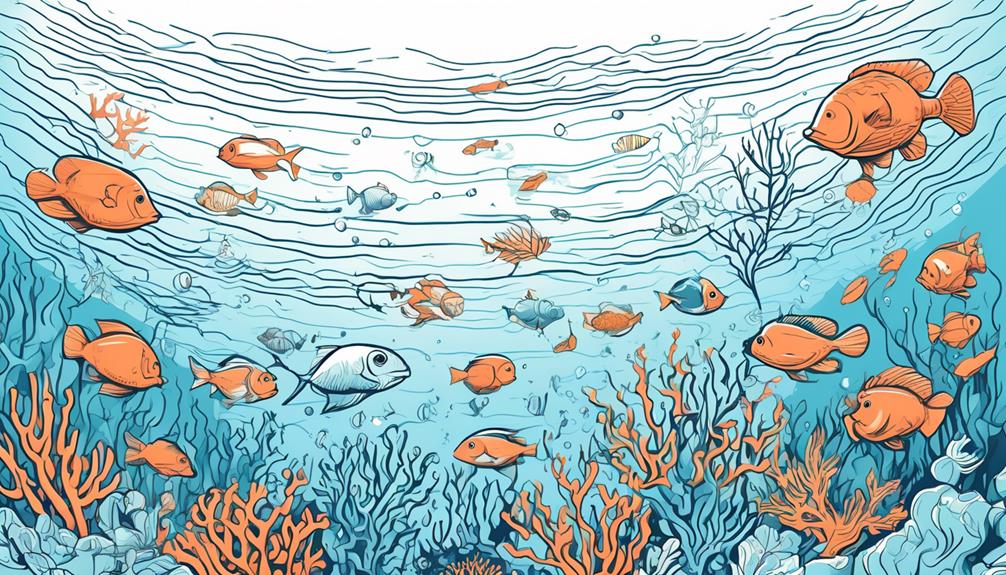Did you know that the seemingly harmless act of pouring that leftover detergent down the drain could have a devastating impact on marine life? It's true!
Water pollution, caused by various contaminants, has a significant and often detrimental effect on our underwater ecosystems. From heavy metals to oil spills, pesticides to plastic waste, the consequences are dire.
Deformities, reproductive problems, and even death plague fish and other aquatic organisms, while oxygen depletion creates suffocating dead zones. But that's just the tip of the iceberg.
Curious to know more about how water pollution wreaks havoc on marine life? Well, let's dive in and explore the deep waters of this pressing issue.
Key Takeaways
- Pathogens present in water pollution can cause devastating outbreaks of diseases in marine animals, leading to weaker immune systems and higher disease prevalence.
- Excess nutrients from land-based sources of pollution have negative effects on marine ecosystems, particularly coral reefs, by stimulating algal growth and disrupting the balance of nutrients needed for coral growth and reproduction.
- Solid waste, especially plastic pollution, harms marine animals through entanglement, ingestion, and the release of harmful chemicals that can contaminate the water and accumulate in the tissues of marine organisms.
- Plastic pollution not only affects marine animals directly but also impacts the food chain, as microplastics are absorbed by small organisms and enter the bodies of larger marine life, leading to health issues and the contamination of the entire food chain.
Pathogens in Water Pollution
Pathogens lurking in water pollution pose a serious threat to marine life, wreaking havoc on their health and resilience. These microscopic organisms can cause devastating outbreaks of diseases in marine animals. For example, corals are particularly vulnerable to pathogens in water pollution. Serratia marcescens, a common pathogen found in wastewater, can lead to specific diseases in corals, impacting their growth and survival. Invertebrates, such as shellfish, are also adversely affected by pathogens present in wastewater. These pathogens can enter their bodies through filter feeding, leading to infections and even death.
The impact of pathogens from wastewater pollution goes beyond individual organisms. They can harm marine life by reducing their ability to fight off diseases. When exposed to high levels of pathogens, marine animals become more susceptible to infections, weakening their immune systems. This increased vulnerability can have cascading effects on the entire ecosystem, as the health and resilience of marine organisms are interconnected.
Weaker immune systems and higher disease prevalence can disrupt the delicate balance of marine ecosystems, leading to population declines and ecosystem degradation.
Nutrient Contamination and Marine Life
Excess nutrients from land-based sources of pollution wreak havoc on marine life, causing coral bleaching and disease. Nutrient contamination, a form of water pollution, can have devastating effects on marine ecosystems. Coral reefs, in particular, are highly susceptible to the negative impacts of nutrient pollution. When excess nutrients, such as nitrogen and phosphorus, enter the water, they stimulate algal growth. This leads to algal overgrowth, which can smother corals and block sunlight, inhibiting their ability to photosynthesize. As a result, corals become stressed and lose their vibrant colors, a phenomenon known as coral bleaching.
Furthermore, nutrient pollution decreases coral reproductivity and skeletal integrity. High nutrient levels can disrupt the delicate balance of nutrients needed for coral growth and reproduction. This can lead to decreased coral cover and biodiversity, as corals struggle to survive in nutrient-rich environments. Additionally, ongoing nutrient loading can lead to algal blooms, which devastate coral reefs and coastal ecosystems. These blooms can deplete oxygen levels in the water, creating hypoxic or anoxic conditions that are harmful to marine life.
Solid Waste and Its Impact on Marine Life
Now let's talk about the impact of solid waste on marine life.
You might be surprised to learn that plastic pollution is a major problem. When plastic debris enters the ocean, it can harm marine animals like sea turtles and seabirds, who mistake it for food and end up ingesting it.
Additionally, harmful chemicals from solid waste can contaminate the water and accumulate in the tissues of marine organisms, posing a threat to their health and survival.
It's important to address this issue and find ways to reduce and properly manage solid waste to protect our precious marine ecosystems.
Plastic Pollution's Effects
Plastic pollution's devastating effects on marine life are a dire consequence of human activity, causing entanglement and ingestion, leading to internal injuries, death, and the contamination of the food chain.
Here are three ways plastic pollution affects marine species:
- Entanglement and ingestion: Marine animals, such as sea turtles and seabirds, mistake plastic debris for food or get entangled in it. This can lead to internal injuries and death, as the plastic obstructs their digestive systems or causes suffocation.
- Contamination of the food chain: Microplastics, tiny pieces of plastic, are absorbed by small organisms like plankton. These organisms are then consumed by larger marine life, such as fish and whales. As a result, the plastic enters the food chain, impacting the health of these animals.
- Accumulation in ocean gyres: Plastic waste tends to accumulate in ocean gyres, large swirling currents. These gyres act as 'plastic soup,' containing vast amounts of plastic debris that can harm marine species inhabiting these areas.
Harmful Chemicals' Impact
Solid waste in our oceans has a significant impact on marine life, including the harmful chemicals it contains and the detrimental effects they can have. When solid waste, such as plastics, enters the water, it can release toxic substances that harm marine animals. These harmful chemicals can lead to various health issues, including reproductive problems, developmental abnormalities, and even death. To better understand the impact of harmful chemicals in solid waste on marine life, let's take a closer look at the table below:
| Harmful Chemicals | Effects on Marine Life | Examples |
|---|---|---|
| Heavy metals | Damage to organs and tissues, impaired reproduction | Mercury, lead |
| Pesticides | Hormonal disruptions, weakened immune systems | DDT, atrazine |
| Petroleum products | Contamination of habitats, suffocation of marine animals | Oil spills |
| Plastics | Ingestion, entanglement, disruption of feeding and digestion | Microplastics, plastic bags |
It is crucial to address the issue of solid waste and its harmful chemicals to protect our marine ecosystems and the countless species that call them home.
Debris and Marine Ecosystems
As we continue our exploration of the impact of water pollution on marine life, let's now turn our attention to the crucial issue of debris and its detrimental effects on marine ecosystems.
The ocean is home to a vast array of marine life, but unfortunately, solid waste poses a significant threat to their survival. Here are three ways in which debris has a negative impact on the marine environment:
- Physical harm: Marine animals can suffer from ingestion and entanglement in marine debris, leading to injuries, suffocation, and even death.
- Disruption of life processes: Debris in the water can disrupt the reproduction and feeding patterns of marine organisms, affecting their survival and overall population health.
- Microplastic pollution: Microplastics, tiny particles of plastic, can be absorbed by small organisms and enter the food chain, potentially causing harm to larger marine animals and even humans who consume seafood.
It is crucial that we address the issue of solid waste in our oceans to protect the delicate balance of marine ecosystems.
Contaminants and Their Effects on Marine Life

Contaminants in the water have detrimental effects on marine life, impacting their health, reproduction, and overall survival. Poor waste management and marine pollution contribute to the presence of toxic chemicals in the water, which can have severe consequences for various marine species.
For instance, pathogens from wastewater pollution can lead to coral diseases and harm invertebrates like shellfish. Excess nutrients from land-based sources can cause coral bleaching, decreased reproduction, and algal overgrowth. These algal blooms, stimulated by nutrient pollution, not only block sunlight but also produce toxins, leading to hypoxic environments.
Moreover, solids present in wastewater can block sunlight, stress and smother corals, and disrupt reproduction and food availability for fish. Additionally, contaminants such as herbicides and synthetic compounds can damage corals, impact reproduction, and accumulate in fish, affecting their mortality rates.
These toxic chemicals not only pose a direct threat to marine organisms but also have long-term effects on the entire ecosystem. Thus, it's crucial to address poor waste management practices and reduce marine pollution to protect the health and survival of marine life.
Endocrine Disruptors in Water Pollution
Endocrine disruptors found in water pollution have a profound impact on the health and stability of marine ecosystems. These chemicals interfere with hormone regulation in marine organisms, leading to a range of negative effects.
Here are three key ways endocrine disruptors in water pollution affect marine life:
- Reproductive and Developmental Abnormalities: Exposure to endocrine disruptors can cause reproductive and developmental abnormalities in marine animals. These chemicals can disrupt the normal functioning of reproductive hormones, leading to reduced fertility, impaired growth and development, and even birth defects in offspring.
- Altered Behavior, Growth, and Immune Function: Endocrine disruptors can also lead to altered behavior, growth, and immune function in marine organisms. Exposure to these chemicals can disrupt the delicate balance of hormones that regulate these processes, resulting in abnormal behaviors, stunted growth, and weakened immune systems.
- Bioaccumulation and Impact on Higher Trophic Levels: Endocrine disruptors have the potential to bioaccumulate in the food chain, meaning that they can build up in the bodies of organisms over time. As a result, higher trophic levels, such as predators and marine mammals, may be exposed to higher concentrations of these chemicals. This can have cascading effects on the entire ecosystem, impacting the health and stability of marine life.
Depletion of Marine Resources Due to Water Pollution

Did you know that water pollution can have a significant impact on fish populations?
The contamination of water bodies by pollutants can lead to a decrease in fish numbers, disrupting the delicate balance of marine ecosystems.
Additionally, harmful algal blooms, fueled by nutrient pollution, can wreak havoc on marine life by blocking sunlight and depleting oxygen.
Furthermore, the destruction of habitats caused by water pollution can further contribute to the depletion of marine resources.
Impact on Fish Population
Water pollution has had a significant impact on the fish population, leading to the depletion of marine resources. Here are three ways in which water pollution affects fish:
- Algal blooms: Excess nutrients from agricultural runoff and sewage discharge can cause algal blooms. These blooms create oxygen-deprived dead zones, making it difficult for fish to survive.
- Oil spills: Spills release toxic substances into the water, coating fish and their habitats. The oil damages the fish's gills, making it hard for them to breathe and reproduce.
- Chemical additives: Chemicals from industrial and household products find their way into water bodies. These additives can disrupt fish hormones, affecting their reproduction and growth.
The fish population's decline due to water pollution not only impacts the ocean ecosystem but also threatens the livelihoods of communities that rely on fishing. It's crucial that we take action to reduce water pollution and protect our fish populations.
Harmful Algal Blooms
Harmful algal blooms, caused by excess nutrients in wastewater, have devastating effects on marine resources, impacting biodiversity and triggering coral bleaching.
These algal blooms, also known as HABs, occur when there's an overabundance of nutrients in the water, such as nitrogen and phosphorus, which come from sources like sewage and agricultural runoff. The excess nutrients stimulate the growth of harmful algae, which can produce toxins that harm marine life.
These blooms can block sunlight from reaching underwater plants, reducing oxygen levels and creating hypoxic environments. As a result, marine organisms that rely on oxygen, such as fish and coral, suffer.
Coral bleaching occurs when stressed corals expel their symbiotic algae, leading to their death.
The devastating impact of harmful algal blooms on marine life highlights the urgent need to address water pollution and its effects on our precious marine resources.
Destruction of Habitats
With the devastating impact of harmful algal blooms on marine life fresh in your mind, it's time to explore the destructive consequences of water pollution on habitats and the depletion of marine resources. Here are three ways in which water pollution leads to the destruction of habitats and the depletion of marine resources:
- Loss of essential habitats: Water pollution threatens marine resources such as coral reefs, seagrass beds, and mangroves. These habitats provide food, shelter, and breeding grounds for countless species. When these habitats are destroyed, the balance of marine ecosystems is disrupted, affecting the survival of many animals.
- Decline in marine biodiversity: Pollution-driven destruction of habitats leads to a decline in marine biodiversity. As habitats are destroyed, many species are forced to leave or perish, causing a loss of species diversity in water bodies.
- Cascading effects on marine life: The depletion of marine resources due to water pollution has cascading effects on the health and sustainability of marine life. When habitats are destroyed, the availability of food and shelter for marine organisms is reduced, impacting their survival and overall well-being.
Water pollution poses a significant threat to the destruction of habitats and the depletion of marine resources. It's crucial that we take action to prevent further damage to our water bodies and protect the animals that rely on them.
Solutions to Mitigate Water Pollution's Impact on Marine Life

To protect our precious marine life, it's crucial that we actively seek out and implement effective solutions to mitigate the harmful impact of water pollution.
One solution is to implement effective waste management practices. By properly disposing of waste and reducing pollution in water bodies, we can help prevent the negative effects of water pollution on marine life.
Another important solution is to promote awareness and education about the impacts of water pollution. By educating individuals about the harmful effects of pollution on marine ecosystems, we can inspire them to take action. Small changes in our daily habits, such as reducing the use of single-use plastics and properly disposing of chemicals, can make a big difference in preventing pollution.
We must also cease the disposal of chemicals and foreign particles in oceans. These substances can contaminate the water and harm marine life. Additionally, it's crucial to keep rivers and local lakes free from debris to prevent contamination from reaching the oceans.
Lastly, addressing water pollution requires a collective effort involving government, relevant agencies, and the public. By working together, we can enforce regulations, implement effective policies, and develop sustainable practices to reduce pollution and protect our marine life.
Frequently Asked Questions
How Can Water Pollution Affect Marine Life?
Water pollution affects marine life in various ways. Excess nutrients from pollution can cause coral bleaching and decreased reproductive capacity. Pathogens harm corals and invertebrates. Algal blooms block sunlight and produce toxins. Solids disrupt food availability. Contaminants damage reproduction and growth. Prevention is crucial.
What Are the Impacts of Ocean Pollution on Marine Life?
Water pollution has devastating impacts on marine life. Ecosystems are disrupted, species face extinction, and coral reefs degrade. It's crucial to understand the consequences and take action to protect these fragile environments.
How Does Water Pollution Affect Animal Life?
Water pollution wreaks havoc on animal life. It destroys habitats, causing marine creatures to lose their homes. Reproductive disorders become rampant, hindering their ability to reproduce. Additionally, bioaccumulation and biomagnification occur, leading to toxic buildup in their bodies.
How Much Marine Life Is Killed by Water Pollution?
Water pollution has devastating effects on marine life. It kills countless organisms, disrupts ecosystems, and threatens biodiversity. The statistics are alarming, but there are solutions to mitigate this damage and protect our precious marine ecosystems.
Conclusion
Wow, water pollution really wreaks havoc on marine life! It's like a never-ending nightmare for our underwater friends. From deformed fish to dead zones where they can't even breathe, the impact is devastating.
And let's not forget about the plastic waste, turning our oceans into death traps for countless marine animals. It's a heart-wrenching reality.
But don't lose hope! We can fight back with education, recycling, and proper waste disposal. Together, we can save our precious marine life from this monstrous pollution.
